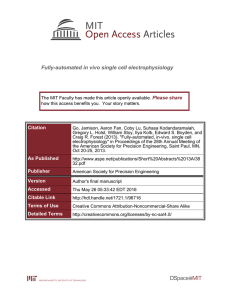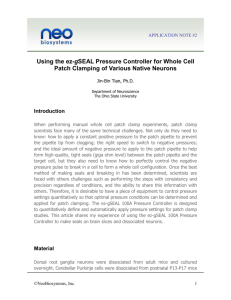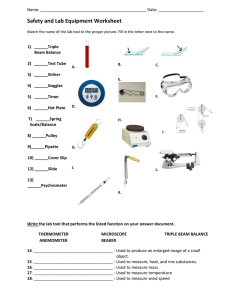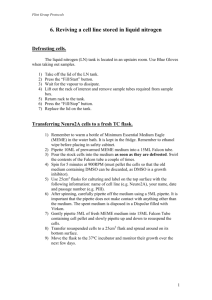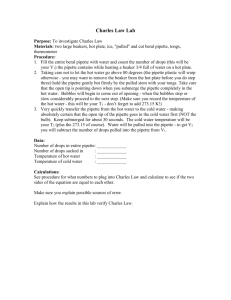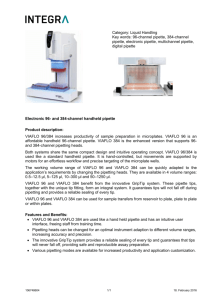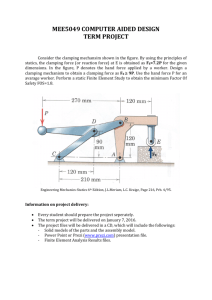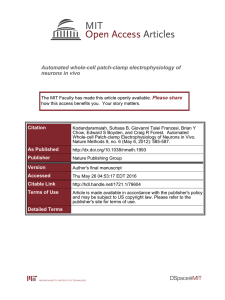FULLY-AUTOMATED IN VIVO SINGLE CELL ELECTROPHYSIOLOGY
advertisement
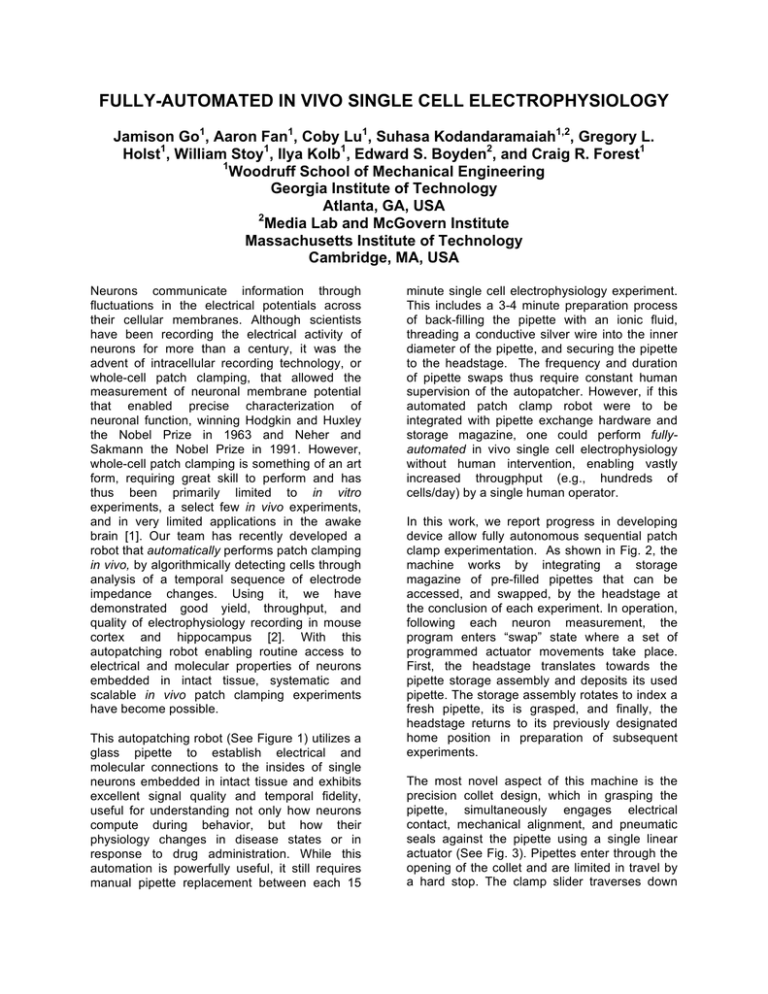
FULLY-AUTOMATED IN VIVO SINGLE CELL ELECTROPHYSIOLOGY Jamison Go1, Aaron Fan1, Coby Lu1, Suhasa Kodandaramaiah1,2, Gregory L. Holst1, William Stoy1, Ilya Kolb1, Edward S. Boyden2, and Craig R. Forest1 1 Woodruff School of Mechanical Engineering Georgia Institute of Technology Atlanta, GA, USA 2 Media Lab and McGovern Institute Massachusetts Institute of Technology Cambridge, MA, USA Neurons communicate information through fluctuations in the electrical potentials across their cellular membranes. Although scientists have been recording the electrical activity of neurons for more than a century, it was the advent of intracellular recording technology, or whole-cell patch clamping, that allowed the measurement of neuronal membrane potential that enabled precise characterization of neuronal function, winning Hodgkin and Huxley the Nobel Prize in 1963 and Neher and Sakmann the Nobel Prize in 1991. However, whole-cell patch clamping is something of an art form, requiring great skill to perform and has thus been primarily limited to in vitro experiments, a select few in vivo experiments, and in very limited applications in the awake brain [1]. Our team has recently developed a robot that automatically performs patch clamping in vivo, by algorithmically detecting cells through analysis of a temporal sequence of electrode impedance changes. Using it, we have demonstrated good yield, throughput, and quality of electrophysiology recording in mouse cortex and hippocampus [2]. With this autopatching robot enabling routine access to electrical and molecular properties of neurons embedded in intact tissue, systematic and scalable in vivo patch clamping experiments have become possible. This autopatching robot (See Figure 1) utilizes a glass pipette to establish electrical and molecular connections to the insides of single neurons embedded in intact tissue and exhibits excellent signal quality and temporal fidelity, useful for understanding not only how neurons compute during behavior, but how their physiology changes in disease states or in response to drug administration. While this automation is powerfully useful, it still requires manual pipette replacement between each 15 minute single cell electrophysiology experiment. This includes a 3-4 minute preparation process of back-filling the pipette with an ionic fluid, threading a conductive silver wire into the inner diameter of the pipette, and securing the pipette to the headstage. The frequency and duration of pipette swaps thus require constant human supervision of the autopatcher. However, if this automated patch clamp robot were to be integrated with pipette exchange hardware and storage magazine, one could perform fullyautomated in vivo single cell electrophysiology without human intervention, enabling vastly increased througphput (e.g., hundreds of cells/day) by a single human operator. In this work, we report progress in developing device allow fully autonomous sequential patch clamp experimentation. As shown in Fig. 2, the machine works by integrating a storage magazine of pre-filled pipettes that can be accessed, and swapped, by the headstage at the conclusion of each experiment. In operation, following each neuron measurement, the program enters “swap” state where a set of programmed actuator movements take place. First, the headstage translates towards the pipette storage assembly and deposits its used pipette. The storage assembly rotates to index a fresh pipette, its is grasped, and finally, the headstage returns to its previously designated home position in preparation of subsequent experiments. The most novel aspect of this machine is the precision collet design, which in grasping the pipette, simultaneously engages electrical contact, mechanical alignment, and pneumatic seals against the pipette using a single linear actuator (See Fig. 3). Pipettes enter through the opening of the collet and are limited in travel by a hard stop. The clamp slider traverses down the collet with the assistance of a linear actuator which compresses the collet flexure and deforms the rubber end, forming a seal. Simultaneously, two magnets constrained to the clamp slider control the position of a ferromagnetic bead levitating within the collet and thread the silver wire as the assembly descends. cellular measurement of neural network dynamics in the living brain Machineinformation performance predicted by error cance: Neurons communicate through was fluctuations in the electrical budgeting andhave measured within 197 µmactivity radialof lular membranes. Although scientists been recording the electrical entury, it was the advent of intracellular recording technology, whole-cell patch repeatability, sufficient for patch orclamping in a e measurement of neuronal membranecraniotomy potential that (a enabled precise characterization conventional 1 mm diameter hole ing Hodgkin and Huxley the Nobel Prize in 1963 and Neher and Sakmann the Nobel in theis skull to access brain). The total whole-cell patch clamping something of an artthe form, requiring great skillpipette to perform exchange atime at 88 from ily limited to in vitro experiments, selectwas few inmeasured vivo experiments, andsec in very limited brain [1]. Our team has developed atorobot that position. automatically performs patch endrecently of experiment home It has been thmically detecting cells through analysis of a temporal sequence of electrode observed to exchange a full magazine of 20 ng it, we have demonstrated good yield, throughput, and quality of recording in pipettes in autopatching sequence failure ampus (See Figure 1a) [2]. With this robot without enabling routine accessor to We report progress in roperties of neurons assistance. embedded in intact tissue,will systematic and scalable in vivo patch ve become possible. performing the first sequential patch clamping recordings without intevention, which ublished experiments demonstrating in vivohuman intracellular recordings of two or ynaptically connected, considered the Holy of neuroscience. could usher inonea ofnew era Grails of fully automated in sible, since even skilled electrophysiologists require significant time to attain a viable vivo neuroscience. euron, subsequent pursuit of a second neuron unfailingly results in loss of the first. able the simultaneous search for two or more neurons in vivo, thus providing a REFERENCES time and human operator constraints of conventional experiments. Success in this a wealth of studies regarding the propagation of neural signals across synaptic S, [1] Poulet JF, Fernandez LM, Crochet etofore only been considered in highly artificial, in vitro experiments. Importantly, Petersen CC, Thalamic control of cortical that neuronal function is very different from in vitro to in vivo conditions, and from states, NatofNeurosci. Vol we 22;15(3):370-2. nditions, necessitating the development the technology describe here. [2] S. Kodandaramaiah, G. Franzesi, B. Chow, niques, in which imaging can be utilized for patch clamping synaptically connected E. Boyden, C.R. Automated mping deep in the brain is “blind”. Locating evenForest, a single neuron requireswholesome luck, patch clamp We electrophysiology of air of neurons is like findingcell a needle in a haystack. propose to utilize sub-circuits to significantly neurons increase the of identifying synapticallyVol connected inodds vivo, Nature Methods. 9, p. l utilize the thalamocortical circuit in the mouse vibrissa/whisker pathway as a model 585–587. ere there is a substantial convergence of projections from the thalamus to the input y (tactile) cortex (See Figure 1b). The Stanley Laboratory has extensive experience b) and electrophysiological recordings (Figure 1c) in this circuit, and is one of only a de that has successfully recorded from synaptically connected pairs of neurons using Figure 1c, [3]). Thus we seek to demonstrate the first simultaneous intracellular l circuit in the living brain to reveal its neural network dynamics. : a robot for in vivo ative current clamp mated patch clamping 2 s-long pulses of – ction), and at rest ance, 44 MΩ; input ell 832 µm below brain mal model system – m. There is an explicit cial whiskers to nstem, thalamus, and mus and cortex will be puter-controlled ers. c. Anatomical ions from thalamus to antly increases the ically connected pairs as extensive ation and recording of ns in this pathway [3]. FIGURE 1. The autopatcher: a robot for in vivo patch clamping with representative current clamp traces during whole cell automated patch clamping of a cortical neuron. FIGURE 2. Model (top) and photo (bottom) of the machine for automated pipette swapping. FIGURE 3. The pipette (See Fig. 1) is held by a novel collet design in the automated patch assembly (See Fig. 2) to simultaneously engage electrical contact, mechanical alignment, and pneumatic seals against the pipette using a single linear actuator.
